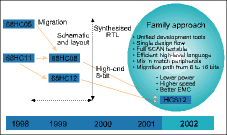
Motorola has one of the world's largest 16 bit microcontroller development teams, with more than 100 designers and engineers worldwide. Its position as the No 1 supplier of 16 bit controllers to the automotive industry has already been achieved. And now Motorola's 16 bit HCS12 MCUs are dedicated to penetrating a wide range of industries and a myriad of applications, such as in white goods, motor control, PC peripherals, displays, and general-purpose products.
Traditionally, the focus of Motorola's 16-bit solutions has been in the area of body control features in the automotive space - features like power windows and power seats, and networking systems like controller area networks, or CAN, and local interconnect networks, or LIN. Motorola has had great success in the global automotive market and Motorola is now building on these successes and moving into other markets with new, general-purpose HCS12 derivatives.

Third-generation flash
Motorola's 16-bit HCS12 family of microcontrollers is the next generation of the industry-standard 68HC12 architecture. This family uses Motorola's third-generation flash technology. An important benefit is that this technology offers an upward migration path from the 68HC08, the 68HC11, and the 68HC12 families. Motorola chose a system-on-a-chip design methodology for the HCS12 family to help improve quality and reduce time-to-market. The HCS12 family offers a wide variety of memory and peripheral options for scalable system designs and flexibility. As consumers continue to demand more functionality from products, the use of flash memory in microcontrollers is becoming a standard requirement. All of the devices in the HCS12 family use this 0,25 mm third generation flash, which offers benefits, such as strict testing requirements, affordable MCUs, easy field upgrades, and fast programming times. And because the size of a 0,25 mm flash cell is quickly approaching that of a ROM cell, it is becoming much more affordable. The third-generation flash programs across the full operating voltage range and has flexible block protection and security features.
Motorola's 16 bit HCS12 roadmap is currently broken up into three families. First, there is the HCS12-D family, targeted at the automotive market. Second, there is the HCS12-A family, targeted at the general-purpose market. Third, there is the HCS12-H family, the application-specific family. Pin-for-pin, each of these families is upward and backward-compatible across its memory ranges for both hardware and software. This versatility means customers can begin designing today with the D 256K device, but later, go into production with the D 32K device.
Motorola's development kit for the HCS12 D and A families includes a BDM multilink cable, which provides realtime incircuit emulation, debugging, and programming for all HC12 and HCS12 MCUs, an evaluation board with a user prototyping area, and CDs containing Metrowerk's Codewarrior integrated development environment.
For further information contact Arrow Altech Distribution, 011 923 9600, Avnet Kopp, 011 444 2333, or EBV-Elektrolink, 021 421 5350.
| Tel: | +27 11 923 9600 |
| Email: | [email protected] |
| www: | www.altronarrow.com |
| Articles: | More information and articles about Altron Arrow |
| Tel: | +27 11 236 1900 |
| Email: | [email protected] |
| www: | www.ebv.com |
| Articles: | More information and articles about EBV Electrolink |
© Technews Publishing (Pty) Ltd | All Rights Reserved